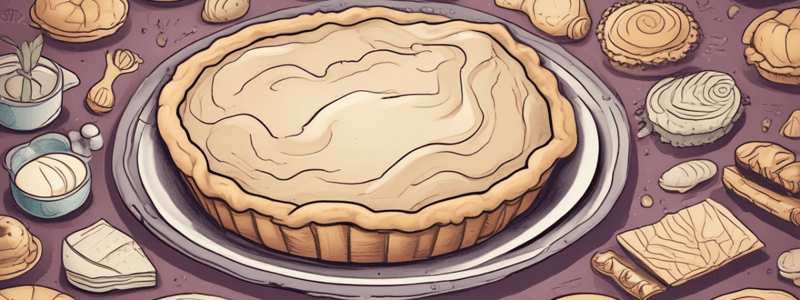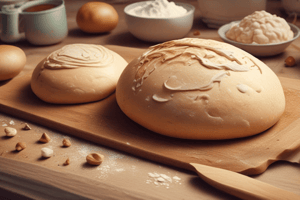Podcast
Questions and Answers
Why should you avoid stretching the dough when placing it into the pan?
Why should you avoid stretching the dough when placing it into the pan?
- To prevent the dough from shrinking during baking (correct)
- To prevent air bubbles from forming between the dough and the pan
- To ensure the crust is crispy
- To make the dough easier to roll out
What is the purpose of fluting or crimping the edges of a single-crust pie?
What is the purpose of fluting or crimping the edges of a single-crust pie?
- To seal the edges of the crust
- To make the pie easier to serve
- To prevent crust shrinkage
- To add extra decoration to the pie (correct)
Why should you rest the made-up pies for 20-30 minutes before baking?
Why should you rest the made-up pies for 20-30 minutes before baking?
- To give the baker a break
- To allow the filling to set
- To prevent crust shrinkage (correct)
- To make the crust easier to roll out
What is the recommended way to trim off excess dough from a pie crust?
What is the recommended way to trim off excess dough from a pie crust?
Why should you avoid creating air bubbles between the dough and the pan?
Why should you avoid creating air bubbles between the dough and the pan?
What is the purpose of making a raised, fluted rim of dough on pie shells for soft-filled pies?
What is the purpose of making a raised, fluted rim of dough on pie shells for soft-filled pies?
When making a double-crust pie, what should you do to the edge of the crust before adding the top crust?
When making a double-crust pie, what should you do to the edge of the crust before adding the top crust?
Why should you fold the dough in half when placing it into the pan?
Why should you fold the dough in half when placing it into the pan?
What is the main reason mealy doughs are used for bottom crusts, especially for soft pie fillings?
What is the main reason mealy doughs are used for bottom crusts, especially for soft pie fillings?
What is the ideal weight of dough for a 9-in. top crust?
What is the ideal weight of dough for a 9-in. top crust?
Why do experienced bakers use less dough when rolling out crusts?
Why do experienced bakers use less dough when rolling out crusts?
What is the purpose of dusting the bench and rolling pin with flour?
What is the purpose of dusting the bench and rolling pin with flour?
Why is it recommended to roll the dough out on flour-dusted canvas?
Why is it recommended to roll the dough out on flour-dusted canvas?
What is the ideal thickness for a rolled-out pie crust?
What is the ideal thickness for a rolled-out pie crust?
What should you do to ensure the dough is not sticking while rolling it out?
What should you do to ensure the dough is not sticking while rolling it out?
What is the definition of 'pan size' in this context?
What is the definition of 'pan size' in this context?
Flashcards are hidden until you start studying
Study Notes
Selecting and Scaling Doughs
- Mealy pie doughs are used for bottom crusts, especially for soft pie fillings like custard and pumpkin, as they resist soaking better than flaky doughs.
- Flaky pie doughs are best for top crusts and prebaked pie shells with cooled filling, but mealy dough is safer for prebaked shells with hot filling.
Scaling Doughs
- Guidelines for dough weights are:
- 8 oz (225 g) for 9-in. (23-cm) bottom crusts
- 6 oz (170 g) for 9-in. (23-cm) top crusts
- 6 oz (170 g) for 8-in. (20-cm) bottom crusts
- 5 oz (140 g) for 8-in. (20-cm) top crusts
- Experienced bakers use less dough due to their skill in rolling perfect circles, reducing excess dough trimming.
Rolling Out Dough
- Dust the bench and rolling pin lightly with flour to prevent sticking, avoiding excess flour to prevent toughening the dough.
- Rolling on flour-dusted canvas requires less dusting flour.
- Roll out the dough to a uniform 1⁄8-in. (3-mm) thickness, using even strokes from the center outward in all directions, lifting frequently to prevent sticking.
Placing and Finishing Dough
- Lift the dough without breaking it by rolling it around the rolling pin or folding it in half and unfolding it in the pan.
- Press the dough into the pan corners without stretching, as stretched dough will shrink during baking.
- Ensure no air bubbles between the dough and the pan.
- For single-crust pies, flute or crimp the edges and trim excess dough.
- For double-crust pies, fill with cold filling, brush the edge with water, and top with the second crust, sealing the edges and trimming excess dough.
Final Preparations
- Rest made-up pies for 20–30 minutes, preferably refrigerated, to prevent crust shrinkage.
Studying That Suits You
Use AI to generate personalized quizzes and flashcards to suit your learning preferences.




